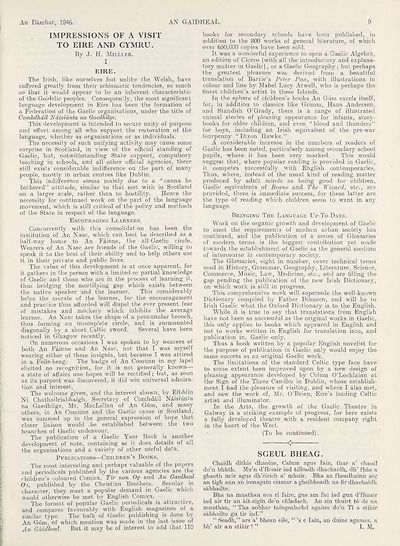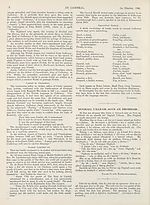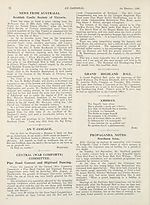Download files
Complete book:
Individual page:
Thumbnail gallery: Grid view | List view

An Damhar, 1946.
AN GAIDHEAL,
9
IMPRESSIONS OF A VISIT
TO EIRE AND CYMRU.
By J. H. Milller.
I
EIRE.
The Irish, like ourselves but unlike the Welsh, have
suffered greatly from their schismatic tendencies, so much
so that it would appear to be an inherent characteristic
of the Goidelic peoples. Consequently, the most significant
language development in Eire has been the formation of
a Federation of the Gaelic organisations, under the title of
Comhdhdil Ndisiunta na Gaedhilge.
This development is intended to secure unity of purpose
and effort among all who support the restoration of the
language, whether as organisations or as individuals.
The necessity of such unifying activity may cause some
surprise in Scotland, in view of the official standing of
Gaelic, but, notwithstanding State support, compulsory
teaching in schools, and all other official agencies, there
still exists considerable indifference on the part of many
people, mostly in urban centres like Dublin.
This indifference seems mainly due to a “ canna be
bothered” attitude, similar to that met with in Scotland
on a larger scale, rather than to hostility. Hence the
necessity for continued work on the part of the language
movement, which is still critical of the policy and methods
of the State in respect of the language.
Encouraging Learners.
Concurrently with this consolidat'on has been the
institution of An Nasc, which can best be described as a
half-way house to An Fainne, the all-Gaelic circle.
Wearers of An Nasc are friends of the Gaelic, willing to
speak it to the best of their ability and to help others use
it in their private and public lives.
The value of this development is at once apparent, for
it gathers in the person with a limited or partial knowledge
of Gaelic and those who are in the process of learning it,
thus bridging the mortifying gap which exists between
the native speaker and the learner. This considerably
helps the morale of the learner, for the encouragement
and practice thus afforded will dispel the ever present fear
of mistakes and mockery which inhibits the average
learner. An Nasc takes the shape of a penannular brooch,
thus forming an incomplete circle, and is surmounted
diagonally by a short Celtic sword. Several have been
noticed in Glasgow recently.
On numerous occasions I was spoken to by wearers of
both An Fainne and An Nasc, not that I was myself
wearing either of these insignia, but because I was attired
in a Feile-beag. The badge of An Comunn in my lapel
elicited no recognition, for it is not generally known—
a state of affairs one hopes will be rectified; but, as soon
as its purport was discovered, it did win universal admira¬
tion and interest.
The welcome given, and the interest shown, by Eibhlin
Ni Chathailriabhaigh, Secretary of Comhdail Naisiunta
na Gaedhilge, Mr. MacLellan of An Gum, and many
others, in An Comunn and the Gaelic cause in Scotland,
was summed up in the general expression of hope that
closer liaison would be established between the two
branches of Gaelic endeavour.
The publication of a Gaelic Year Book is another
development of note, containing as it does details of all
the organisations and a variety of other useful data.
Publications—Children’s Books.
The most interesting and perhaps valuable of the papers
and periodicals published by the various agencies are the
children’s coloured Comics, Tir nan Og and An Gaedheal
Oi, published by the Christian Brothers. Secular in
character, they meet a popular demand in Gaelic which
would otherwise be met by English Comics.
The format of popular Gaelic periodicals is attractive,
and compares favourably with English magazines of a
similar type. The bulk of Gaelic publishing is done by
An Gum, of which mention was made in the last issue of
An Gdidheal. But it may be of interest to add that 110
books for secondary schools have been published, in
addition to the 800 works of general literature, of which
over 650,000 copies have been sold.
It was a wonderful experience to open a Gaelic Algebra,
an edition of Cicero (with all the introductory and explana¬
tory matter in Gaelic), or a Gaelic Geography; but perhaps
the greatest pleasure was derived from a beautiful
translation of Barrie’s Peter Pan, with illustrations in
colour and line by Mabel Lucy Atwell, who is perhaps the
finest children’s artist in these Islands.
In the sphere of children’s books An Giim excels itself,
for, in addition to classics like Grimm, Hans Andersen,
and Standish O’Grady, there is a range of illustrated
animal stories of pleasing appearance for infants, story¬
books for older children, and even “blood and thunders”
for boys, including an Irish equivalent of the pre-war
fourpenny “Dixon Hawke.”
A considerable increase in the numbers of readers of
Gaelic has been noted, particularly among secondary school
pupils, where it has been very marked. This would
suggest that, where popular reading is provided in Gaelic,
it competes successfully with English contemporaries.
Thus, where, instead of the usual kind of reading matter
produced by adult minds as being good for children,
Gaelic equivalents of Beano and The Wizard, etc., are
provided, there is immediate success, for these latter are
the type of reading which children seem to want in any
language.
Bringing The Language Up-To-Date.
Work on the organic growth and development of Gaelic
to meet the requirements of modern urban society has
continued, and the publication of a series of Glossaries
of modern terms is the biggest contribution yet made
towards the establishment of Gaelic as the general medium
of intercourse in contemporary society.
The Glossaries, eight in number, cover technical terms
used in History, Grammar, Geography, Literature, Science,
Commerce, Music, Law, Medicine, etc., and are filling the
gap pending the publication of the new Irish Dictionary,
on which work is still in progress.
This comprehensive work will supersede the well-known
Dictionary compiled by Father Dinneen, and will be to
Irish Gaelic what the Oxford Dictionary is to the English.
While it is true to say that translations from English
have not been so successful as the original works in Gaelic,
this only applies to books which appeared in English and
not to works written in English for translation into, and
publication in, Gaelic only.
Thus a book written by a popular English novelist for
the purpose of publication in Gaelic only would enjoy the
same success as an original Gaelic work.
The limitations of the standard Celtic type face have
to some extent been improved upon by a new design of
pleasing appearance developed by Colum O’Lochlainn at
the Sign of the Three Candles in Dublin, whose establish¬
ment I had the pleasure of visiting, and where I also met,
and saw the work of, Mr. O’Brien, Eire’s leading Celtic
artist and illuminator.
In the Arts, the growth of the Gaelic Theatre in
Galway is a striking example of progress, for here exists
a fully developed theatre with a resident company right
in the heart of the West.
' (To be continued).
❖
SGEUL BHEAG.
Chaidh dithis dhaoine, Calum agus Tain, thar a’ chaoil
do’n bhrith. Mu’n d’fhuair iad tilleadh dhachaidh, dh’ fhas a
ghaoth mor agus dh’eirich a’ mhuir. Bha an fheadhainn aig
an tigh ann an iomagain ciamar a gheibheadh na fir dhachaidh
sabhailte.
Bha na mnathan aca ri faire, gus am fac iad gun d’fhuair
iad air tir an ait-eigin de’n chladaeh. An sin thuirt te de na
mnathan, “ Tha aobhar taingealachd againn do’n T1 a stitiir
sabhailte gu tir iad.”
“ Seadh,”' ars a’ bhean eile, “’s e Iain, an duine agamsa. a
bh’ air an stiuir ! ” I. M.
AN GAIDHEAL,
9
IMPRESSIONS OF A VISIT
TO EIRE AND CYMRU.
By J. H. Milller.
I
EIRE.
The Irish, like ourselves but unlike the Welsh, have
suffered greatly from their schismatic tendencies, so much
so that it would appear to be an inherent characteristic
of the Goidelic peoples. Consequently, the most significant
language development in Eire has been the formation of
a Federation of the Gaelic organisations, under the title of
Comhdhdil Ndisiunta na Gaedhilge.
This development is intended to secure unity of purpose
and effort among all who support the restoration of the
language, whether as organisations or as individuals.
The necessity of such unifying activity may cause some
surprise in Scotland, in view of the official standing of
Gaelic, but, notwithstanding State support, compulsory
teaching in schools, and all other official agencies, there
still exists considerable indifference on the part of many
people, mostly in urban centres like Dublin.
This indifference seems mainly due to a “ canna be
bothered” attitude, similar to that met with in Scotland
on a larger scale, rather than to hostility. Hence the
necessity for continued work on the part of the language
movement, which is still critical of the policy and methods
of the State in respect of the language.
Encouraging Learners.
Concurrently with this consolidat'on has been the
institution of An Nasc, which can best be described as a
half-way house to An Fainne, the all-Gaelic circle.
Wearers of An Nasc are friends of the Gaelic, willing to
speak it to the best of their ability and to help others use
it in their private and public lives.
The value of this development is at once apparent, for
it gathers in the person with a limited or partial knowledge
of Gaelic and those who are in the process of learning it,
thus bridging the mortifying gap which exists between
the native speaker and the learner. This considerably
helps the morale of the learner, for the encouragement
and practice thus afforded will dispel the ever present fear
of mistakes and mockery which inhibits the average
learner. An Nasc takes the shape of a penannular brooch,
thus forming an incomplete circle, and is surmounted
diagonally by a short Celtic sword. Several have been
noticed in Glasgow recently.
On numerous occasions I was spoken to by wearers of
both An Fainne and An Nasc, not that I was myself
wearing either of these insignia, but because I was attired
in a Feile-beag. The badge of An Comunn in my lapel
elicited no recognition, for it is not generally known—
a state of affairs one hopes will be rectified; but, as soon
as its purport was discovered, it did win universal admira¬
tion and interest.
The welcome given, and the interest shown, by Eibhlin
Ni Chathailriabhaigh, Secretary of Comhdail Naisiunta
na Gaedhilge, Mr. MacLellan of An Gum, and many
others, in An Comunn and the Gaelic cause in Scotland,
was summed up in the general expression of hope that
closer liaison would be established between the two
branches of Gaelic endeavour.
The publication of a Gaelic Year Book is another
development of note, containing as it does details of all
the organisations and a variety of other useful data.
Publications—Children’s Books.
The most interesting and perhaps valuable of the papers
and periodicals published by the various agencies are the
children’s coloured Comics, Tir nan Og and An Gaedheal
Oi, published by the Christian Brothers. Secular in
character, they meet a popular demand in Gaelic which
would otherwise be met by English Comics.
The format of popular Gaelic periodicals is attractive,
and compares favourably with English magazines of a
similar type. The bulk of Gaelic publishing is done by
An Gum, of which mention was made in the last issue of
An Gdidheal. But it may be of interest to add that 110
books for secondary schools have been published, in
addition to the 800 works of general literature, of which
over 650,000 copies have been sold.
It was a wonderful experience to open a Gaelic Algebra,
an edition of Cicero (with all the introductory and explana¬
tory matter in Gaelic), or a Gaelic Geography; but perhaps
the greatest pleasure was derived from a beautiful
translation of Barrie’s Peter Pan, with illustrations in
colour and line by Mabel Lucy Atwell, who is perhaps the
finest children’s artist in these Islands.
In the sphere of children’s books An Giim excels itself,
for, in addition to classics like Grimm, Hans Andersen,
and Standish O’Grady, there is a range of illustrated
animal stories of pleasing appearance for infants, story¬
books for older children, and even “blood and thunders”
for boys, including an Irish equivalent of the pre-war
fourpenny “Dixon Hawke.”
A considerable increase in the numbers of readers of
Gaelic has been noted, particularly among secondary school
pupils, where it has been very marked. This would
suggest that, where popular reading is provided in Gaelic,
it competes successfully with English contemporaries.
Thus, where, instead of the usual kind of reading matter
produced by adult minds as being good for children,
Gaelic equivalents of Beano and The Wizard, etc., are
provided, there is immediate success, for these latter are
the type of reading which children seem to want in any
language.
Bringing The Language Up-To-Date.
Work on the organic growth and development of Gaelic
to meet the requirements of modern urban society has
continued, and the publication of a series of Glossaries
of modern terms is the biggest contribution yet made
towards the establishment of Gaelic as the general medium
of intercourse in contemporary society.
The Glossaries, eight in number, cover technical terms
used in History, Grammar, Geography, Literature, Science,
Commerce, Music, Law, Medicine, etc., and are filling the
gap pending the publication of the new Irish Dictionary,
on which work is still in progress.
This comprehensive work will supersede the well-known
Dictionary compiled by Father Dinneen, and will be to
Irish Gaelic what the Oxford Dictionary is to the English.
While it is true to say that translations from English
have not been so successful as the original works in Gaelic,
this only applies to books which appeared in English and
not to works written in English for translation into, and
publication in, Gaelic only.
Thus a book written by a popular English novelist for
the purpose of publication in Gaelic only would enjoy the
same success as an original Gaelic work.
The limitations of the standard Celtic type face have
to some extent been improved upon by a new design of
pleasing appearance developed by Colum O’Lochlainn at
the Sign of the Three Candles in Dublin, whose establish¬
ment I had the pleasure of visiting, and where I also met,
and saw the work of, Mr. O’Brien, Eire’s leading Celtic
artist and illuminator.
In the Arts, the growth of the Gaelic Theatre in
Galway is a striking example of progress, for here exists
a fully developed theatre with a resident company right
in the heart of the West.
' (To be continued).
❖
SGEUL BHEAG.
Chaidh dithis dhaoine, Calum agus Tain, thar a’ chaoil
do’n bhrith. Mu’n d’fhuair iad tilleadh dhachaidh, dh’ fhas a
ghaoth mor agus dh’eirich a’ mhuir. Bha an fheadhainn aig
an tigh ann an iomagain ciamar a gheibheadh na fir dhachaidh
sabhailte.
Bha na mnathan aca ri faire, gus am fac iad gun d’fhuair
iad air tir an ait-eigin de’n chladaeh. An sin thuirt te de na
mnathan, “ Tha aobhar taingealachd againn do’n T1 a stitiir
sabhailte gu tir iad.”
“ Seadh,”' ars a’ bhean eile, “’s e Iain, an duine agamsa. a
bh’ air an stiuir ! ” I. M.
Set display mode to:
![]() Universal Viewer |
Universal Viewer | ![]() Mirador |
Large image | Transcription
Mirador |
Large image | Transcription
| An Comunn Gàidhealach > An Comunn Gàidhealach Publications > Gaidheal > Volume 42, October 1946--September 1947 > (17) Page 9 |
|---|
| Permanent URL | https://digital.nls.uk/125249508 |
|---|
| Description | This contains items published by An Comunn, which are not specifically Mòd-related. It includes journals, annual reports and corporate documents, policy statements, educational resources and published plays and literature. It is arranged alphabetically by title. |
|---|
| Description | A collection of over 400 items published by An Comunn Gàidhealach, the organisation which promotes Gaelic language and culture and organises the Royal National Mòd. Dating from 1891 up to the present day, the collection includes journals and newspapers, annual reports, educational materials, national Mòd programmes, published Mòd literature and music. |
|---|---|
| Additional NLS resources: |
|

